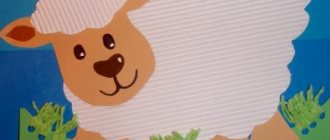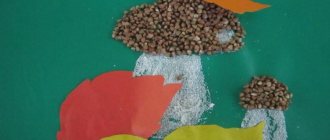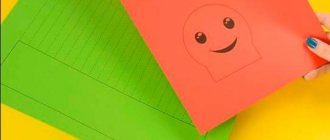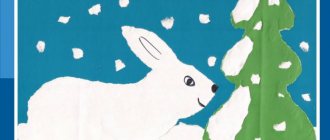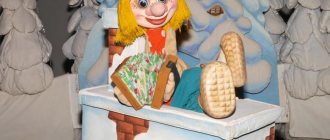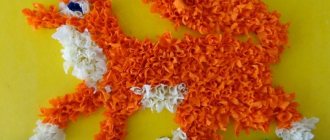Materials for children's activities
For classes in a kindergarten group, materials must be prepared in advance. For the application you will need:
- colored paper;
- glue;
- templates;
- scissors.
Templates depicting animal figures must be prepared in advance. For kids you need to choose simpler figures, for older groups - more complex ones.
Craft Panda
Panda facts:
- Pandas are an endangered species.
- They eat about 28 pounds of bamboo a day!
- Adult pandas weigh about 300 pounds (136 kg).
- Wild pandas live only in remote mountainous areas of China.
- Pandas are solitary animals.
Paper animal applications
A colored picture of a domestic or wild animal should be cut into several parts and the kids should be asked to assemble it like a puzzle and stick it on a sheet of white paper.
An older child can be given a black and white drawing of an animal so that he can color it himself, cut it into pieces, and then assemble and paste it. The applique turns out even more interesting if the children are given cut out parts of the animal - the body, head, paws and tail. The child himself shows creativity and assembles his own unique applique.
Cat
Cut out the details of the cat: round head, oval body and legs, long tail, ears from ¼ circle. Invite children to assemble a picture from a set of parts, and then color the cat.
Piglet
The body, legs, head, tail, ears and details of the face are cut out of colored paper: nose, snout, eyes. The children themselves must collect the pig and stick it on a piece of paper. In the older group, you can complicate the task, for example, make the tail voluminous.
Cow
Young children are given animal parts to stick on. Older children can cut out a few cows themselves and stick them on a green piece of paper to create a grazing herd. You can draw part of the craft.
Chanterelle
It is interesting to assemble appliques of foxes and other wild animals from geometric shapes. The head and ears can be triangular, the tail, body and paws can be oval. The face can be drawn with a felt-tip pen.
Lion clipping
Facts about lions:
- Lions live in groups called "prides".
- Male lions boast a mane, a large fringe that encircles their heads.
- Males defend the pride territory, which they clearly mark with the smell of their urine.
- Lionesses are hunters in a pride. They often work together to hunt antelope, zebra, wildebeest, zebra, etc.
- Most lions on earth live in Africa, although a very small population can be found in India's Gir Forest.
Cotton wool applications
Cotton wool is a very convenient material for application. First you need to give the children the base - the outline of the animal drawn on a piece of paper. Pieces of cotton wool need to be glued to the “shaggy” parts of the animal: the body, the head. And cut out the remaining parts from paper and glue them. The results are very cute and life-like animals.
The cotton wool can be glued simply in pieces, or in rolled balls. For example, a lamb looks natural when the wool is glued on it with balls. The picture looks three-dimensional. You can even paint the cotton wool with paints, and then you will get a real children's masterpiece.
Gorilla cutout
Gorilla Facts:
- Gorillas are classified as endangered.
- There are only 700 mountain gorillas left on Earth.
- Although their numbers are slowly increasing due to conservation efforts, habitat loss and poaching still pose a major threat to these animals.
- Baby gorillas love to ride on their mother's back.
- Gorillas are herbivores and primarily eat bamboo and other leafy plants.
- Gorillas can live 40-50 years.
- They are very smart!
Napkin applications
This application is very useful for children, as it strengthens fine motor skills. The napkins are first torn into small pieces by hand, and then balls are rolled out of these pieces. The balls are glued to the base of the animal image. Today, napkins are available in a variety of colors and designs. Therefore, children's animal applications can turn out to be very interesting and colorful.
Craft Leopard
Leopard Facts:
- Leopards are an endangered species.
- They are strong hunters and love to be in trees. In fact, they often drag their prey up trees to eat it!
- They are nocturnal.
- Leopards are very secretive and hunt antelope and deer under the cover of tall grass.
- They are also good swimmers and love to be in the water.
- Leopards are light colored with black spots called rosettes. There are also black leopards, commonly known as black panthers .
Applications from other available materials
Sometimes the most unexpected materials are suitable for applique animals. For example, to imitate the wool of a lamb, you can stick pasta “horns” on paper, and it will look like it’s alive. Rabbit skin can be made from white or gray threads. You just need to choose thicker threads, for example wool.
To make an applique of a hedgehog, it is appropriate to make its body from buckwheat glued to paper. And the body of a chicken or a bear is made of millet.
A very convenient material for applique animals is plasticine. It is easy to process, painted in different colors, and it is also a favorite material for children for various crafts. Small pieces of plasticine are simply kneaded in your hands and applied to the base drawing for applique until the entire picture of the animal is painted in the desired color. This results in a 3D effect.
Baboon cutout
Facts about baboons:
- There are 5 different species of baboons and they all live in Africa or Arabia.
- Baboons are one of the largest monkeys in the world. Males weigh on average from 15-37 kg.
- Baboons prefer savanna and other semi-arid habitats.
- They don't have prehensile tails like other monkeys, but they can climb trees to sleep, eat, or wait out trouble.
- Baboons eat fruits, herbs, seeds, bark, roots, meat and love to eat farm crops.
- They are known to form large orders of baboons, ranging from tens to hundreds with a complex hierarchical system.
- They can live about 30 years.
Penguin applique master class
Children love not only animals from hot countries or pets, but also residents of the north. Children in the middle groups of kindergartens will enjoy the master class on making a paper penguin. Here are the step-by-step instructions:
- cut out a black oval for the body;
- cut out a smaller white oval for the tummy;
- cut out black triangular wings, brown triangular flippers and a yellow triangular beak;
- Glue all the parts onto the base.
The cheerful little penguin is ready.
Animal appliqué develops children's creative abilities and perseverance. There are a lot of photos and templates on the Internet on the topic of children's applications with animals.
Craft Warthog
Facts about warthogs:
- The "spikes" and bumps on a warthog's face... those are warts!
- They are from the same family as the cute domestic pigs, although they look different.
- They have 4 tusks (although our template only shows two).
- They eat grass and plants and dig up roots and bulbs.
- They live for about 15 years.
- Warthogs can go for long periods without drinking water.
Hedgehog
To make a hedgehog you will need:
- Toilet paper roll;
- Brown cardboard;
- Orange cardboard;
- Scissors;
- Glue;
- Felt pen.
Operating instructions:
- A toilet paper roll is covered with orange cardboard - this will be the body of the hedgehog;
- From brown cardboard you need to cut an oval of such a size that it protrudes beyond the body.
- Trim the edge with a zigzag to create needles;
- Then the needles are glued to the body, a muzzle is drawn - eyes, nose and mouth;
- You can also cut out two small strips from orange cardboard - these will be the hands of the hedgehog.
Piggy
Even a preschooler can handle such a simple craft. With the guidance of your parents, you can easily create a funny pig. By the way, such a craft can even be converted into a cap, because its shape allows this.
To work you will need:
- Cardboard or thick pink paper;
- Glue;
- Scissors;
- Felt pen.
Operating instructions:
- For the base you will need a pink paper cone. To fold a cone, you need to draw a circle and divide it into 2 halves, cutting out one of them;
- From this half of the circle you will need to form a cone, adjusting its thickness when gluing;
- The base is ready, now all that remains is the details. Ears, snout, tail and eyes are cut out from pink cardboard. The pupils can be drawn with a black felt-tip pen.
- All parts are glued to the piglet. Below you only need to draw on the mouth, and the craft is complete.
- If you thread a thin elastic band inside the craft, you will get a festive hat.
